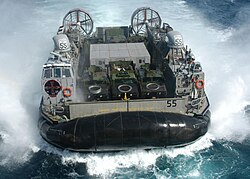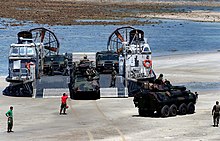Landing Craft Air Cushion
|
||||||||||||
|
||||||||||||
|
||||||||||||
|
||||||||||||
Landing craft air cushion (LCAC) (German: " landing craft air cushion") is a type of air cushion - landing craft of the United States Navy .
development
The LCAC were developed in 1980 and deployed in the first task force in 1989. 1991 in the Second Gulf War was the largest operation of LCAC to date. In 1993 they landed on the coast of Somalia in front of the cameras .
Due to their ability to land large quantities of vehicles and material quickly and in a targeted manner, independently of the usual traffic routes, LCAC also proved to be an ideal aid for disaster relief in coastal areas. At the beginning of 2005 they were used in Sri Lanka to distribute aid after the 2004 Indian Ocean earthquake . In early September 2005, LCAC of the USS Bataan (LHD-5) loaded with trucks full of relief supplies landed on the beach in Biloxi , Mississippi in support of relief efforts after Hurricane Katrina .
The US Navy has 91 LCACs in total. 74 of them are in active service, the rest in reserve or maintenance. The active LCAC are assigned to either Assault Craft Unit 4 on Naval Amphibious Base Little Creek in Virginia Beach , Virginia ( Atlantic Fleet ) or Assault Craft Unit 5 at Marine Corps Base Camp Pendleton in Coronado , California ( Pacific Fleet ).
The amphibious multi-purpose ships of the US Navy can accommodate two, three or even four LCAC in their well deck , depending on the type ( LHD , LPD , LSD ) .
The big advantage of the LCAC is not only the higher speed compared to normal landing craft, but also the fact that it can reach around 80% of all coasts and land troops without having to wade through the water, compared to around 17% with regular boats .
Hovercraft can also operate over ice and the beach. The classic unsafe landing zone in the surf, such as the landings in World War II, can thus be avoided; Troops and equipment can be transported to a place inland, whereby with a total height of the skirt (rubber apron) of about 1.30 m obstacles up to 0.30 m high can be driven over.
This concept of bringing heavy equipment from the high seas up to 80 kilometers directly to the beach is called OTH ( over the horizon ) and could previously only be carried out with helicopters, and only to a limited extent.
Technical specifications

- Crew: 5
- Dimensions
- Length: 26.4 m
- Width: 14.3 m
- Displacement: 200 t
- Speed: 40 kn with cargo, otherwise up to ~ 70 knots
- Propulsion system:
- Power: 4 Avco Lycoming gas turbines, 12,280 hp
- Propeller: 2 drive and 4 lift propellers
- Consumption: 3800 liters (1000 gallons ) / hour
- Range: 200 miles at 40 knots, 300 miles at 35 knots
- Armament:
- 2 × 12.7 mm Browning M2 machine guns
- 2 × 40 mm machine grenade launchers Mk 19
- Freight: 60 to 75 tons
Future development
As a further development, the Heavy Lift Landing Craft Air Cushion (HLCAC) with 144 tons of loading capacity and a 33% larger loading area was considered. This means that two can M1A1 or ten LAVs be transported.
Currently (2011) the HLCAC project was abandoned and there are plans and a contract for the procurement of 72 ship-to-shore connector hovercraft. These are LCACs that have been further developed in some points. Among other things, stronger and more efficient engines, a two-man cockpit, the use of lighter materials in construction as well as higher speed and higher payload.

